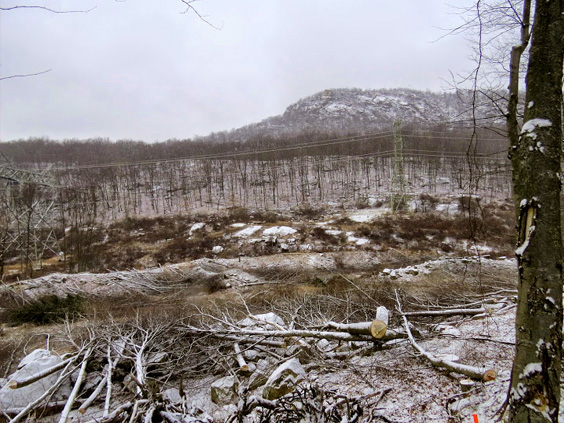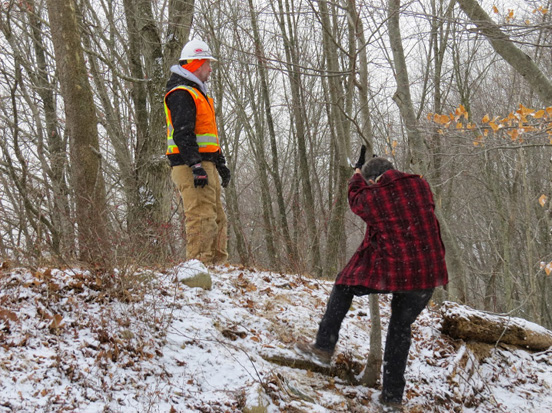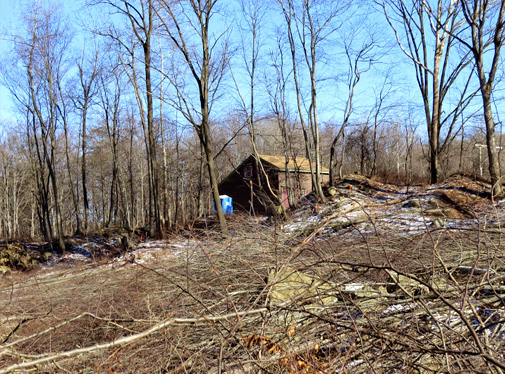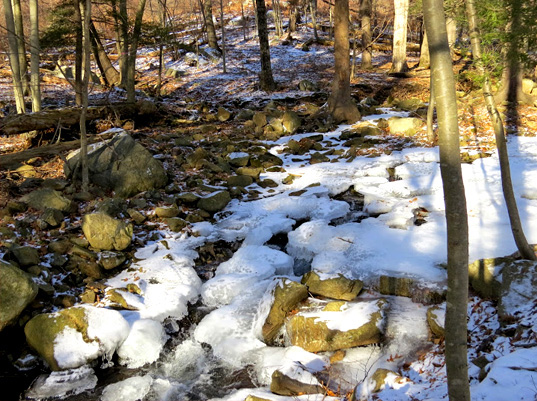
Arcadis began preparation for continuing environmental remediation work in Torne Valley at the site of a former sand quarry. Torne Mountain is seen in the distance. / Photo by Geoff Welch
Before Torne Valley was a Superfund site, parts of it were used as a sand quarry, with the sand deposits part of the valley’s natural aquifer — now classified by NY state as a principle aquifer and used as a major regional water supply. Back in the 1950s, pockets of the valley were dug through along Torne Brook for natural resources. Those sandy areas eventually became a graveyard for paint sludge brought in from the former Ford Motor Company plant in Mahwah, NJ.

Chuck Stead climbs up a hill near the Ramapo Saltbox in Torne Valley to confer with Arcadis consultant. / Photo by Geoff Welch
Stead said that the Saltbox and Torne Valley paint sludge initiatives have had instrumental support by Town of Ramapo Supervisor Christopher St. Lawrence — and have become important parts of the town’s continuing historic preservation efforts.
Chuck Stead trapped the valley as a kid and remembers when pickup trucks with tarps over the barrels parked around the old sand quarry area, which was a perfect place to sink a load of unwanted toxic dreck.
“If you could put six barrels in the back of your truck and make them disappear in the middle of the night, you’d get a hundred dollar bill,” Stead said about the the old days, before regulations and oversight curbed corporate behavior.
“I smelled the paint,” said Stead. “It was liquid then and it was strong.”

The Ramapo Saltbox sits adjacent to a former sand quarry and dump site for paint sludge from the Ford Motor Co. Mahwah, NJ, plant. / Photo by Geoff Welch
With the construction of the tiny Ramapo Saltbox Environmental Research Center (ERC) in Torne Valley, Stead has helped oversee cleanup of Torne Valley. Ford Motor continues the environmental remediation effort throughout the valley, which mainly involves locating the pockets of paint sludge and removing the toxic gray gunk.
Town of Ramapo Supervisor Christopher St. Lawrence has been an advocate of town historical preservation as well as lending weight to the paint sludge clean up. The Ramapo Saltbox and Sloatsburg’s Jacob Sloat House, known as Harmony Hall, are two efforts by St. Lawrence to preserve local history.

An iced over Torne Brook runs down from the wetlands around Pine Meadow Lake in Harriman State Park, and winds through Torne Valley, skirting areas where paint sludge was buried back in the 1970s. / Photo by Geoff Welch
Ford Motor contracted with engineering firm Arcadis to supervise Torne Valley remediation work. Preparation for spring work has started in the OU2 area of the United Water well field that includes some 13 acreas alongside the Ramapo Saltbox house. The preparation included whole sections of trees that have been cut out of an area behind the Saltbox to access the 1950s sand quarry where paint sludge was dumped.
Arcadis anticipates remediation work will begin in mid-April, and is scheduled to work around native Indiana bat habitats.
Stead’s long view vision for the reclamation of Torne Valley includes the Ramapo Saltbox as an expansive educational and cultural hub, with the tiny reconstructed shack standing as a sentinel beside the capped Ramapo landfill.


